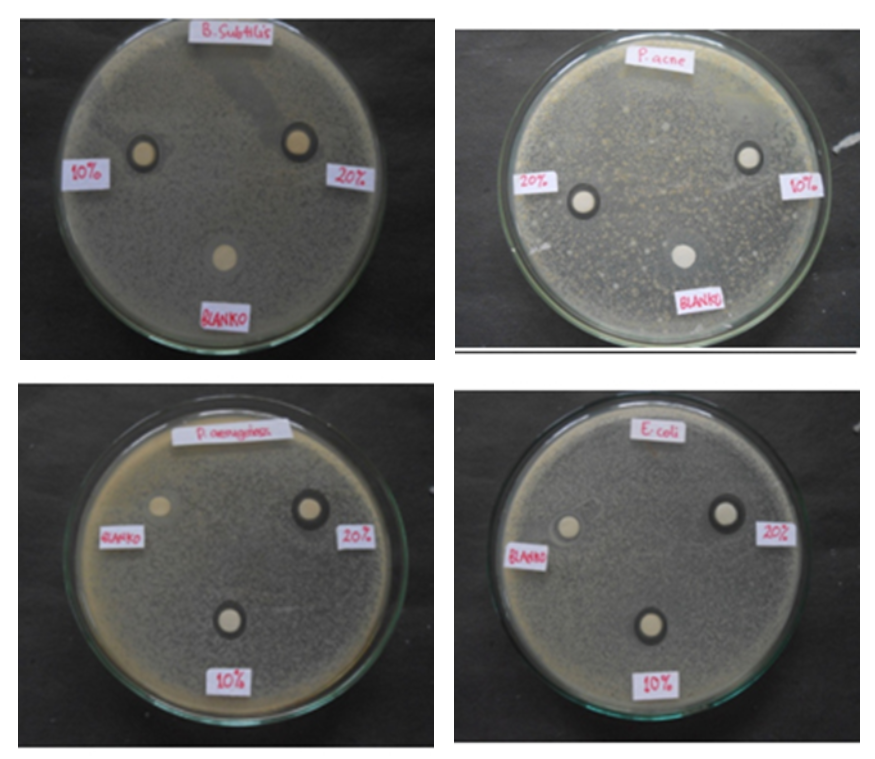Analysis of Chemical Components and Antibacterial Activity in Essential Oil of Lantana Flowers (Lantana Camara L)
Abstract
The purpose of this study was to evaluate the essential oil composition as well as antibacterial activities of essential oil of Lantana camara L flowers against four bacterial strains. Essential oil of Lantana camara L flowers was obtained by hydrodistillation method using Sthal and analyzed by GC-MS. The antibacterial activities of essential oil were tested by using disk diffusion method against four bacterial strains. Results showed 72 compounds for Lantana flowers essential oil, of which caryophyllene (10,87%), davanone (9.84%), a-humulene (7.59%), a-curcumene (3.35%), germacrene D (3.09%), calarene (2.42%), a-muurolene (2.27%), p-cymene (1.79%), 1,8 cineole (1.59%) , δ-cadinene (1.59%), a-copaene (1.12%), nerolidol B (1%) and ß-ocimene (0.54%) were detected as major components. Antibacterial activity assay of Lantana camara L flowers essential oil was examined against four bacterial strains including Gram (+and-) by using disk diffusion agar method. All the tested Gram (+and-) bacterial strains displayed slight to moderate antibacterial activity (7 – 10 mm) against all concentrations of essential oil. The essential oil of Lantana camara L flowers showed remarkable antibacterial activity with inhibition in concentrations of 10% and 20% against the phatogen bacterias Basillus subtilis (9.6 mm; 10.8 mm), Propionibacterium acnes ( 7.6 mm; 8.7 mm), Eschechia coli ( 8.4 mm ; 9.6 mm) and Pseudomonas aeruginosa ( 8.3 mm ; 9.3 mm) showed from zone of inhibition that was formed, zone of inhibition in concentration 20% was bigger than concentration 10%.
References
Ajitha, B., Ashok Kumar Reddy, Y., Shameer, S., Rajesh, K. M., Suneetha, Y., & Sreedhara Reddy, P. (2015). Lantana camara leaf extract mediated silver nanoparticles: Antibacterial, green catalyst. Journal of Photochemistry and Photobiology B: Biology, 149, 84–92. https://doi.org/10.1016/j.jphotobiol.2015.05.020
Al-Dhahli, A. S., Al-Hassani, F. A., Mohammed Alarjani, K., Mohamed Yehia, H., Al Lawati, W. M., Najmul Hejaz Azmi, S., & Alam Khan, S. (2020). Essential oil from the rhizomes of the Saudi and Chinese Zingiber officinale cultivars: Comparison of chemical composition, antibacterial and molecular docking studies. Journal of King Saud University - Science, 32(8), 3343–3350. https://doi.org/10.1016/j.jksus.2020.09.020
Al Zuhairi, J. J. M. J., Jookar Kashi, F., Rahimi-Moghaddam, A., & Yazdani, M. (2020). Antioxidant, cytotoxic and antibacterial activity of Rosmarinus officinalis L. essential oil against bacteria isolated from urinary tract infection. European Journal of Integrative Medicine, 38(August), 101192. https://doi.org/10.1016/j.eujim.2020.101192
Ashmawy, N. A., Salem, M. Z. M., EL-Hefny, M., Abd El-Kareem, M. S. M., El-Shanhorey, N. A., Mohamed, A. A., & Salem, A. Z. M. (2018). Antibacterial activity of the bioactive compounds identified in three woody plants against some pathogenic bacteria. Microbial Pathogenesis, 121(May), 331–340. https://doi.org/10.1016/j.micpath.2018.05.032
Ayalew, A. A. (2020). Chromatographic and spectroscopic determination of solvent-extracted Lantana camara leaf oil. Journal of International Medical Research, 48(10). https://doi.org/10.1177/0300060520962344
Babarinde, S. A., Olaniran, O. A., Ottun, A. T., Oderinde, A. E., Adeleye, A. D., Ajiboye, O., & Dawodu, E. O. (2021). Chemical composition and repellent potentials of two essential oils against larger grain borer, Prostephanus truncatus (Horn.) (Coleoptera: Bostrichidae). Biocatalysis and Agricultural Biotechnology, 32(September 2020), 1–6. https://doi.org/10.1016/j.bcab.2021.101937
Bajalan, I., Rouzbahani, R., Pirbalouti, A. G., & Maggi, F. (2017). Antioxidant and antibacterial activities of the essential oils obtained from seven Iranian populations of Rosmarinus officinalis. Industrial Crops and Products, 107(February), 305–311. https://doi.org/10.1016/j.indcrop.2017.05.063
Barros, L. M., Duarte, A. E., Morais-Braga, M. F. B., Waczuk, E. P., Vega, C., Leite, N. F., De Menezes, I. R. A., Coutinho, H. D. M., Rocha, J. B. T., & Kamdem, J. P. (2016). Chemical characterization and trypanocidal, leishmanicidal and cytotoxicity potential of Lantana camara L. (verbenaceae) essential oil. Molecules, 21(2). https://doi.org/10.3390/molecules21020209
Bevilacqua, A. H. V., Suffredini, I. B., Romoff, P., Lago, J. H. G., & Bernardi, M. M. (2011). Toxicity of apolar and polar Lantana camara L. crude extracts in mice. Research in Veterinary Science, 90(1), 106–115. https://doi.org/10.1016/j.rvsc.2010.05.001
Buchanan, T. A., Xiang, A., Kjos, S. L., & Watanabe, R. (2007). What is gestational diabetes? Diabetes Care, 30(SUPPL. 2). https://doi.org/10.2337/dc07-s201
Cecchini, M. E., Paoloni, C., Campra, N., Picco, N., Grosso, M. C., Soriano Perez, M. L., Alustiza, F., Cariddi, N., & Bellingeri, R. (2021). Nanoemulsion of Minthostachys verticillata essential oil. In-vitro evaluation of its antibacterial activity. Heliyon, 7(1), e05896. https://doi.org/10.1016/j.heliyon.2021.e05896
Crusell, M. K. W., Hansen, T. H., Nielsen, T., Allin, K. H., Rühlemann, M. C., Damm, P., Vestergaard, H., Rørbye, C., Jørgensen, N. R., Christiansen, O. B., Heinsen, F. A., Franke, A., Hansen, T., Lauenborg, J., & Pedersen, O. (2018). Gestational diabetes is associated with change in the gut microbiota composition in third trimester of pregnancy and postpartum. Microbiome, 6(1), 89. https://doi.org/10.1186/s40168-018-0472-x
Dougnon, G., & Ito, M. (2020). Sedative effects of the essential oil from the leaves of Lantana camara occurring in the Republic of Benin via inhalation in mice. Journal of Natural Medicines, 74(1), 159–169. https://doi.org/10.1007/s11418-019-01358-9
Goudjil, M. B., Ladjel, S., Bencheikh, S. E., Zighmi, S., & Hamada, D. (2015). Chemical compounds profile, antibacterial and antioxidant activities of the essential oil extracted from the Artemisia herba-alba of Southern Algeria. International Journal of Biological Chemistry, 9(2), 70–78. https://doi.org/10.3923/ijbc.2015.70.78
Guliani, A., Pooja, Verma, M., Kumari, A., & Acharya, A. (2021). Retaining the ‘essence’ of essential oil: Nanoemulsions of citral and carvone reduced oil loss and enhanced antibacterial efficacy via bacterial membrane perturbation. Journal of Drug Delivery Science and Technology, 61(November 2020), 102243. https://doi.org/10.1016/j.jddst.2020.102243
Hazrati, S., Govahi, M., Sedaghat, M., & Beyraghdar Kashkooli, A. (2020). A comparative study of essential oil profile, antibacterial and antioxidant activities of two cultivated Ziziphora species (Z. clinopodioides and Z. tenuior). Industrial Crops and Products, 157(September), 112942. https://doi.org/10.1016/j.indcrop.2020.112942
Huang, K., Liu, R., Zhang, Y., & Guan, X. (2021). Characteristics of two cedarwood essential oil emulsions and their antioxidant and antibacterial activities. Food Chemistry, 346(September 2020), 128970. https://doi.org/10.1016/j.foodchem.2020.128970
Janardhan, B. S., & Vijayan, K. (2012). Types of endophytic bacteria associated with traditional medicinal plant Lantana camara Linn. Pharmacognosy Journal, 4(32), 20–23. https://doi.org/10.5530/pj.2012.32.4
Kazmi, I., Afzal, M., Ali, B., Damanhouri, Z. A., Ahmaol, A., & Anwar, F. (2013). Anxiolytic potential of ursolic acid derivative-a stearoyl glucoside isolated from Lantana camara L. (verbanaceae). Asian Pacific Journal of Tropical Medicine, 6(6), 433–437. https://doi.org/10.1016/S1995-7645(13)60069-3
Khalid, K. A. (2019). Harvest stages and their influences on Lantana camara L. essential oil. Biocatalysis and Agricultural Biotechnology, 22(October), 101403. https://doi.org/10.1016/j.bcab.2019.101403
Mulyaningsih, S., Sporer, F., Zimmermann, S., Reichling, J., & Wink, M. (2010). Synergistic properties of the terpenoids aromadendrene and 1,8-cineole from the essential oil of eucalyptus globulus against antibiotic-susceptible and antibiotic-resistant pathogens. Phytomedicine, 17(13), 1061–1066. https://doi.org/10.1016/j.phymed.2010.06.018
Nea, F., Kambiré, D. A., Genva, M., Tanoh, E. A., Wognin, E. L., Martin, H., Brostaux, Y., Tomi, F., Lognay, G. C., Tonzibo, Z. F., & Fauconnier, M. L. (2020). Composition, seasonal variation, and biological activities of lantana camara essential oils from Côte d’Ivoire. Molecules, 25(10). https://doi.org/10.3390/molecules25102400
Obistioiu, D., Cristina, R. T., Schmerold, I., Chizzola, R., Stolze, K., Nichita, I., & Chiurciu, V. (2014). Chemical characterization by GC-MS and in vitro activity against Candida albicans of volatile fractions prepared from Artemisia dracunculus, Artemisia abrotanum, Artemisia absinthium and Artemisia vulgaris. Chemistry Central Journal, 8(1), 1–11. https://doi.org/10.1186/1752-153X-8-6
Patil, S. P., & Kumbhar, S. T. (2018). Evaluation of terpene-rich extract of Lantana camara L. leaves for antimicrobial activity against mycobacteria using Resazurin Microtiter Assay (REMA). Beni-Suef University Journal of Basic and Applied Sciences, 7(4), 511–515. https://doi.org/10.1016/j.bjbas.2018.06.002
Randrianalijaona, J. A., Ramanoelina, P. A. R., Rasoarahona, J. R. E., & Gaydou, E. M. (2005). Seasonal and chemotype influences on the chemical composition of Lantana camara L.: Essential oils from Madagascar. Analytica Chimica Acta, 545(1), 46–52. https://doi.org/10.1016/j.aca.2005.04.028
Rodenak-Kladniew, B., Castro, A., Stärkel, P., Galle, M., & Crespo, R. (2020). 1,8-Cineole promotes G0/G1 cell cycle arrest and oxidative stress-induced senescence in HepG2 cells and sensitizes cells to anti-senescence drugs. Life Sciences, 243(December 2019), 117271. https://doi.org/10.1016/j.lfs.2020.117271
Salem, M. Z. M., Ali, H. M., El-Shanhorey, N. A., & Abdel-Megeed, A. (2013). Evaluation of extracts and essential oil from Callistemon viminalis leaves: Antibacterial and antioxidant activities, total phenolic and flavonoid contents. Asian Pacific Journal of Tropical Medicine, 6(10), 785–791. https://doi.org/10.1016/S1995-7645(13)60139-X
Septiana, S., Yuliana, N. D., Bachtiar, B. M., Putri, S. P., Fukusaki, E., Laviña, W. A., & Wijaya, C. H. (2020). Metabolomics approach for determining potential metabolites correlated with sensory attributes of Melaleuca cajuputi essential oil, a promising flavor ingredient. Journal of Bioscience and Bioengineering, 129(5), 581–587. https://doi.org/10.1016/j.jbiosc.2019.12.005
Seth, R., Mohan, M., Singh, P., Haider, S. Z., Gupta, S., Bajpai, I., Singh, D., & Dobhal, R. (2012). Chemical composition and antibacterial properties of the essential oil and extracts of Lantana camara Linn. from Uttarakhand (India). Asian Pacific Journal of Tropical Biomedicine, 2(3 SUPPL.), S1407–S1411. https://doi.org/10.1016/S2221-1691(12)60426-2
Soulaimani, B., Hidar, N. El, Ben El Fakir, S., Mezrioui, N., Hassani, L., & Abbad, A. (2021). Combined antibacterial activity of essential oils extracted from Lavandula maroccana (Murb.), Thymus pallidus Batt. and Rosmarinus officinalis L. against antibiotic-resistant Gram-negative bacteria. European Journal of Integrative Medicine, 43(October 2020), 101312. https://doi.org/10.1016/j.eujim.2021.101312
Taylor, P., Asso, A., Salido, S., Altarejos, J., Nogueras, M., & Sanchez, A. (2011). Chemical Composition of the Essential Oil of Chemical Composition of the Essential Oil of Artemisia herba-al6a Asso SSP . valentina ( Lam .) M a d. January 2013, 37–41.
Verma, V., & Balasubramanian, K. (2014). Experimental and theoretical investigations of Lantana camara oil diffusion from polyacrylonitrile membrane for pulsatile drug delivery system. Materials Science and Engineering C, 41, 292–300. https://doi.org/10.1016/j.msec.2014.04.061
Wang, J., Zheng, J., Shi, W., Du, N., Xu, X., Zhang, Y., Ji, P., Zhang, F., Jia, Z., Wang, Y., Zheng, Z., Zhang, H., & Zhao, F. (2018). Dysbiosis of maternal and neonatal microbiota associated with gestational diabetes mellitus. Gut, 67(9), 1614–1625. https://doi.org/10.1136/gutjnl-2018-315988
Wang, Y. H., & Zhang, Y. R. (2020). Variations in compositions and antioxidant activities of essential oils from leaves of Luodian Blumea balsamifera from different harvest times in China. PLoS ONE, 15(6), 1–15. https://doi.org/10.1371/journal.pone.0234661
Xia, S., Dong, J., Chen, Y., Wang, Y., & Chen, X. (2018). Three dimensional phytic acid-induced graphene as a solid-phase microextraction fiber coating and its analytical applications for nerolidol in tea. Chinese Chemical Letters, 29(1), 107–110. https://doi.org/10.1016/j.cclet.2017.10.008
Yin, H., Wang, C., Yue, J., Deng, Y., Jiao, S., Zhao, Y., Zhou, J., & Cao, T. (2021). Optimization and characterization of 1,8-cineole/hydroxypropyl-β-cyclodextrin inclusion complex and study of its release kinetics. Food Hydrocolloids, 110(July 2020), 106159. https://doi.org/10.1016/j.foodhyd.2020.106159
Zhu, F., Lu, W. H., Pan, J. H., Huang, M. Z., & Wu, J. S. (2013). Chemical composition and antibacterial activity of essential oils from the leaves, fruits and stems of Lantana camara L. from the South China. Advanced Materials Research, 781–784, 1060–1063. https://doi.org/10.4028/www.scientific.net/AMR.781-784.1060
Zoubiri, S., & Baaliouamer, A. (2011). Larvicidal activity of two Algerian Verbenaceae essential oils against Culex pipiens. Veterinary Parasitology, 181(2–4), 370–373. https://doi.org/10.1016/j.vetpar.2011.04.033
Zoubiri, S., & Baaliouamer, A. (2012). GC and GC/MS analyses of the Algerian Lantana camara leaf essential oil: Effect against Sitophilus granarius adults. Journal of Saudi Chemical Society, 16(3), 291–297. https://doi.org/10.1016/j.jscs.2011.01.013























